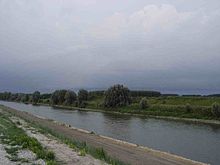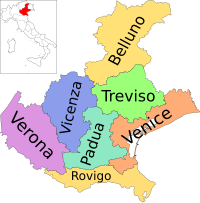
Adria is a town and comune in the province of Rovigo in the Veneto region of northern Italy, situated between the mouths of the rivers Adige and Po. The remains of the Etruscan city of Atria or Hatria are to be found below the modern city, three to four metres below the current level. Adria and Spina were the Etruscan ports and depots for Felsina. Adria may have given its name during an early period to the Adriatic Sea, to which it was connected by channels.
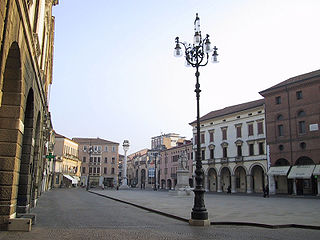
Rovigo is a city and comune in the Veneto region of Northeast Italy, the capital of the eponymous province.

Polesine is a geographic and historic area in the north-east of Italy whose limits varied through centuries; it had also been known as Polesine of Rovigo for some time.
The War of Ferrara was fought in 1482–1484 between Ercole I d'Este, Duke of Ferrara, and the Papal forces mustered by Ercole's personal nemesis, Pope Sixtus IV and his Venetian allies. Hostilities ended with the Treaty of Bagnolo, signed on 7 August 1484.

Lendinara is a comune in the province of Rovigo, Veneto, northern Italy. It is part of the historical and geographical region of Polesine.
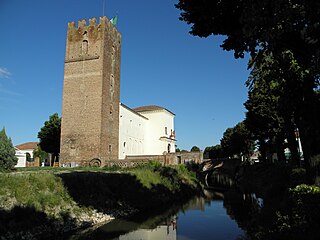
Arquà Polesine is a comune (municipality) in the Province of Rovigo in the Italian region Veneto, located about 70 kilometres (43 mi) southwest of Venice and about 7 kilometres (4 mi) southwest of Rovigo.

Badia Polesine is a comune (municipality) in the Province of Rovigo in the Italian region Veneto, located about 70 kilometres southwest of Venice and about 25 kilometres west of Rovigo. It is part of the upper Polesine, and is bounded by the Adige river, which separates the communal territory from the province of Padua.

Bosaro is a comune (municipality) in the Province of Rovigo in the Italian region Veneto, located about 60 kilometres (37 mi) southwest of Venice and about 8 kilometres (5 mi) south of Rovigo.
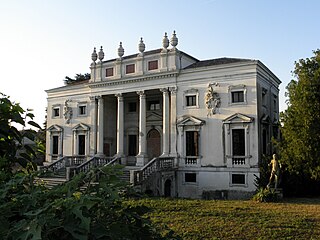
Canda is a comune (municipality) in the Province of Rovigo in the Italian region Veneto, located about 80 km southwest of Venice and about 20 kilometres (12 mi) west of Rovigo. As of 31 December 2004, it had a population of 958 and an area of 14.4 square kilometres (5.6 sq mi).

Corbola is a comune (municipality) in the Province of Rovigo in the Italian region Veneto, located about 50 kilometres (31 mi) southwest of Venice and about 25 kilometres (16 mi) southeast of Rovigo.

Guarda Veneta is a comune (municipality) in the Province of Rovigo in the Italian region of Veneto, located about 60 kilometres (37 mi) southwest of Venice and about 9 kilometres (6 mi) south of Rovigo.

Loreo is a comune (municipality) in the Province of Rovigo in the Italian region Veneto, located about 40 kilometres (25 mi) south of Venice and about 35 kilometres (22 mi) east of Rovigo. As of 31 December 2004, it had a population of 3,873 and an area of 39.6 square kilometres (15.3 sq mi).

Polesella is a comune (municipality) in the Province of Rovigo in the Italian region Veneto, located about 70 kilometres southwest of Venice and about 11 km (7 mi) south of Rovigo.

Rosolina is a comune (municipality) in the Province of Rovigo in the Italian region Veneto, located about 40 kilometres (25 mi) south of Venice and about 35 kilometres (22 mi) east of Rovigo. As of 31 December 2004, it had a population of 6,303 and an area of 73.1 square kilometres (28.2 sq mi).

Taglio di Po is a comune (municipality) in the Province of Rovigo in the Italian region Veneto, located about 50 kilometres (31 mi) south of Venice and about 35 kilometres (22 mi) east of Rovigo, in the lower Polesine.

Trecenta is a comune (municipality) in the Province of Rovigo in the Italian region Veneto, located about 80 kilometres (50 mi) southwest of Venice and about 25 kilometres (16 mi) west of Rovigo.
Villamarzana is a comune (municipality) in the Province of Rovigo in the Italian region Veneto, located about 70 kilometres (43 mi) southwest of Venice and about 10 kilometres (6 mi) southwest of Rovigo. As of 31 December 2004, it had a population of 1,176 and an area of 14.1 square kilometres (5.4 sq mi).

Cavarzere is a comune (municipality) in the Metropolitan City of Venice in the Italian region of Veneto, located about 35 kilometres southwest of Venice.

Tartaro-Canalbianco-Po di Levante is a river of north-east Italy. It is the only river whose course runs between the Adige river and the Po river and flows into the Adriatic Sea.

The so-called breach at Cucca traditionally refers to a flood in the Veneto region of Italy that should have happened on October 17, 589 according to the chronicles of Paul the Deacon. The Adige river overflowed after a "deluge of water that is believed not to have happened after the time of Noah"; the flood caused great loss of lives, and destroyed part of the city walls of Verona as well as paths, roads and large part of the country in lower Veneto.



